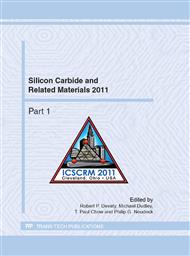p.1179
p.1183
p.1187
p.1191
p.1195
p.1199
p.1203
p.1207
p.1211
Laser-Doped SiC as Wireless Remote Gas Sensor Based on Semiconductor Optics
Abstract:
An uncooled SiC-based electro-optic device is developed for gas sensing applications. P-type dopants Ga, Sc, P and Al are incorporated into an n-type crystalline 6H-SiC substrate by a laser doping technique for sensing CO2, CO, NO2 and NO gases, respectively. Each dopant creates an acceptor energy level within the bandgap of the substrate so that the energy gap between this acceptor level and the valence band matches the quantum of energy emitted by the gas of interest. The photons of the gas excite electrons from the valence band to the acceptor level, which alters the electron density in these two states. Consequently, the refractive index of the substrate changes, which, in turn, modifies the reflectivity of the substrate. This change in reflectivity represents the optical signal of the sensor, which is probed remotely with a laser such as a helium-neon laser. Although the midwave infrared (3-5 mm) band is studied in this paper, the approach is applicable to other spectral bands.
Info:
Periodical:
Pages:
1195-1198
Citation:
Online since:
May 2012
Authors:
Price:
Сopyright:
© 2012 Trans Tech Publications Ltd. All Rights Reserved
Share:
Citation:


